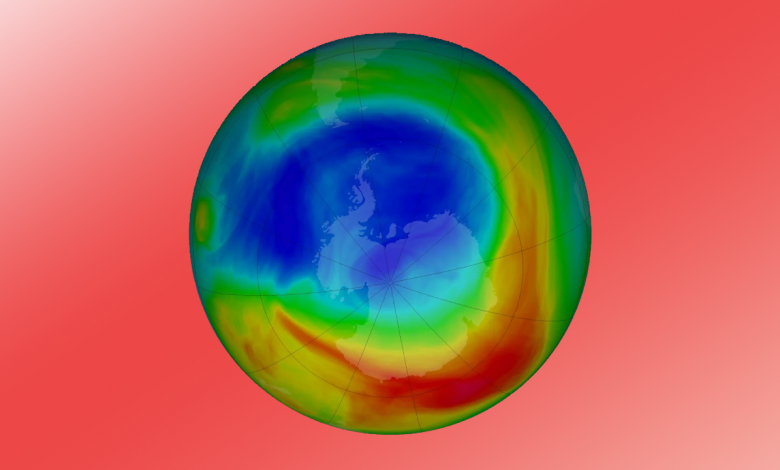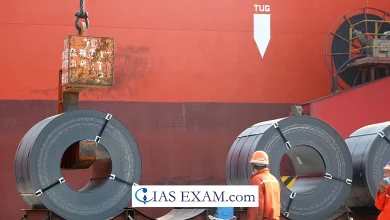
Context- A recent scientific assessment has suggested that the ozone hole is expected to be completely repaired by 2066.
Key Highlights
Recovery period:
- The ozone layer over Antarctica, where the hole is the most prominent, will take more time to heal completely.
- If ongoing policies continued to be implemented, the ozone layer was expected to recover to 1980 values by 2066 over Antarctica, by 2045 over the Arctic, and by 2040 for the rest of the world.
- Over the rest of the world, the ozone layer is expected to be back to its previous condition in 1980 by 2040 itself.
How it became possible:
- Successful elimination of certain harmful industrial chemicals, together referred to as Ozone Depleting Substances or ODSs.
- Proper implementation of the 1989 Montreal Protocol.
- About 99 per cent of the substances banned by the Montreal Protocol have now been eliminated from use, resulting in a slow but definite recovery of the ozone layer.
Ozone:
- Ozone i.e. chemically, a molecule having three Oxygen atoms, or O3 is found mainly in the upper atmosphere, an area called stratosphere, between 10 and 50 km from the Earth’s surface.
- It is critical for planetary life, as it absorbs ultraviolet rays coming from the Sun.
- UV rays cause skin cancer and many other diseases and deformities in plants and animals.
Damage to the ozone layer
- The depletion of the ozone layer, first noticed in the early 1980s, used to be one of the biggest environmental threats before climate change came along.
Hole or just reduction?
- Though the problem is commonly referred to as the emergence of a ‘hole’ in the ozone layer, it is actually a reduction in concentration of the ozone molecules.
- Even in the normal state, ozone is present in very low concentrations in the stratosphere. Where the ‘layer’ is supposed to be the thickest, there are no more than a few molecules of ozone for each million air molecules.
Sharp reductions in concentrations of Ozone:
- In the 1980s, scientists started noticing a sharp drop in its presence.
- And this drop in concentration was much more pronounced over the South Pole.
- It was further linked to the unique meteorological conditions that prevail over Antarctica such as
- Temperature,
- Pressure,
- Wind speed and
- Direction
Biggest hole during months:
- The ozone hole over Antarctica is the biggest during the months of September, October, and November of the year.
Main cause deciphered:
- The use of a class of industrial chemicals which contained chlorine, bromine or fluorine.
- The most common of these were the chlorofluorocarbons, or CFCs, which were used extensively in the air conditioning, refrigeration, paints, and furniture industries.
Montreal Protocol:
- It was with this climate change objective in mind that the Montreal Protocol was amended in 2016 in order to extend its mandate over hydrofluorocarbons, or HFCs, that have replaced the CFCs in industrial use.
- HFCs do not cause much damage to the ozone layer and the reason is they were not originally banned but are very powerful greenhouse gases.
Kigali Amendment:
- The Kigali Amendment to the Montreal Protocol suggests eliminating 80-90 per cent of the HFCs currently in use by the year 2050.
- It is expected to prevent another 0.3 to 0.5 degree Celsius of global warming by the turn of the century.
Timeline
- Before 1979:
-
-
- Scientists had not noticed atmospheric ozone concentrations below 220 Dobson Units (DU; measure of the total amount of ozone in a vertical column of air above the Earth’s surface).
-
- 1980s and after:
-
- In the early 1980s, scientists using ground-based and satellite measurements started realising that the Earth’s natural sunscreen was thinning dramatically over the South Pole each spring.
- The thinning of the ozone layer over Antarctica came to be known as the ozone hole.
- In 1979, the maximum depth of the hole was 194 Dobson Units (DU). However in 1982, it fell to 173 DU, in 1983 to 154 DU, and in 1985 to 124 DU.
- In 1991, ozone concentration was noticeably below 100 DU for the first time. The deepest hole was in 1994, when concentrations fell to 73 DU on Sept 30.
Significance
-
- Ozone layer covers the entire planet and protects life on earth by absorbing harmful ultraviolet-B (UV-B) radiation from the sun.
- Impact on Plants
-
-
- Plants cannot live and grow in heavy ultraviolet radiation, nor can the planktons which serve as food for most of the ocean life.
-
- Health impact of UV-B rays
-
- With a weakening of the Ozone Layer shield, humans would be more susceptible to skin cancer, cataracts as well as impaired immune systems.
- Without it, life may have been impossible on earth due to harmful UV-B rays.
Ozone-Depleting Substances:
- Their elimination has a crucial climate change co-benefit as they are powerful greenhouse gases.
- Many of them are hundreds or even thousands of times more dangerous than carbon dioxide, the most abundant greenhouse gas and the main driver of global warming.
- Global compliance to the Montreal Protocol ensures the avoidance of 0.5 to 1 degree Celsius of global warming by 2050.
- That is if the use of CFCs and other similar chemicals had continued to grow the way it did before they were banned, the world would have been 0.5 to 1 degree Celsius warmer than presently it is.
Concerns
-
- Replacements available:
- The use of ODSs, though extensive, was restricted to certain specific industries.
- Their replacements were readily available, even if at a slightly higher cost.
- The impact of banning these ozone-depleting chemicals was hence limited to these specific sectors.
- With some incentives, these sectors have recovered from the initial disruption and are thriving again.
- Replacements available:
- Carbon footprints:
-
- Emission of carbon dioxide is linked to the harnessing of energy.
- Almost all economic activity leads to carbon dioxide emissions. Even renewable energies, like solar or wind, have considerable carbon footprints right now, because their manufacturing, transport, and operation involves the use of fossil fuels.
- Greenhouse gas emissions:
- The emissions of methane, the other major greenhouse gas, comes mainly from agricultural practices and livestock farming.
- The impact of restraining greenhouse gas emissions is not limited to a few particular industries or economic sectors, but affects the entire economy, and also has implications for the quality of life, human lifestyles and habits and behaviours.
Way Ahead
- It should be ensured that existing restrictions on ozone-depleting substances are properly implemented and global use of ozone-depleting substances continue to be reduced.
- Also banks of ozone-depleting substances (both in storage and contained in existing equipment) should be dealt with in an environmentally-friendly manner and are replaced with climate-friendly alternatives.
- Permitted uses of ozone-depleting substances are not diverted to illegal uses.
- Reducing use of ozone-depleting substances in applications which are not considered as consumption under the Montreal Protocol.
- Ensuring that no new chemicals or technologies emerge that could pose certain new threats to the ozone layer (e.g. very short-lived substances).





.png)



